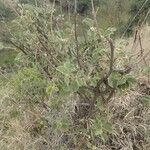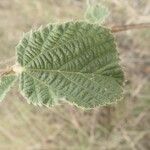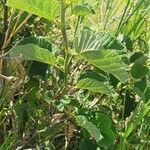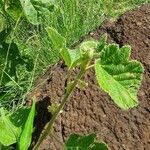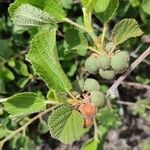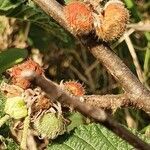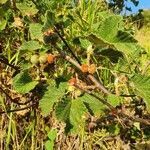Shrub 1.2–4.5 m high, plants apparently either bisexual or unisexual; stems flattened; young shoots densely covered with villous hairs.. Leaves broadly ovate to orbicular, 2–15 cm long, 1.6–18.5 cm wide, rounded to obtuse or slightly apiculate at the apex, rounded to cordate at the base, margin serrate, pubescent above, more so on the veins, densely stellate-pubescent beneath with long simple hairs on the veins; veins prominent and finely reticulate, leaves appearing bullate when young; petiole 0.6–5.5 cm long, densely villous; stipules broadly ovate to ovate-lanceolate, 5–10 mm long, caducous.. Inflorescence a 2–10-flowered cyme.. Flowers dull red, yellow or brownish; sepals 5–10 mm long, densely hairy on the outside, usually reddish on the inside; petals much smaller than sepals, 1–3 mm long, usually pinkish.. Androgynophore glabrous.. Stamens up to 3 mm long; filaments whitish; anthers yellow.. Ovary densely villous; style 1.5–3 mm long; stigma much divided.. Fruit unlobed, subglobose, flattened vertically, 1–1.6 cm in diameter, orange to rusty-brown, covered with small warts tipped by long hairs, outer wall crustaceous and well-separated from the pulp.. Fig. 6.
A shrub. It grows 2-4 m tall. It is usually much branched. It loses its leaves during the year. The leaves are oval or round and are large. They are 2.5-14 cm across. They have teeth along the edges. They are copper coloured. There are downy hairs on both surfaces. The leaves are more pale underneath. The fruit is red and hairy. The have 4 shallow lobes. They are 12 mm across. The fruit are edible.
Leaf-lamina up to 12 cm. in diam., subcircular to broadly elliptic, apex rounded, margin serrate, slightly cordate at the base and sometimes asymmetric, sparsely pubescent, green and finely reticulate above, grey-pubescent or villous below; veins prominent and reticulate; petiole up to 4 cm. long, setulose-pubescent; stipules 5–12 mm. long, ovate to broadly oblanceolate, pubescent, submembranous.
Petals yellow, about half the length of the sepals, oblong or obovate-oblong, with a basal nectariferous claw circumvillous within but not extended above into a narrow ledge, nectary and lamina of about equal length, pubescent behind the nectary and along the mid-line of the lamina.
Inflorescences leaf-opposed or frequently arising some distance from the node; peduncle up to 5 mm. long, pubescent; pedicels similar, up to 3 mm. long; bracts c. 7 mm. long, ovate, similar to the stipules.
Shrub, 1-3 m high. Leaves suborbicular to broadly elliptic, veins reticulate. Inflorescences leaf-opposed and often arising some distance from node. Flowers yellow.
Ovary not lobed, densely villous; style c. 3 mm. long, pubescent, especially towards the base; stigma divided into many laciniate segments.
Fruit reddish, c. 15 mm. in diam., globose, shallowly 4-lobed, with small scattered tubercles bearing rather long caducous setulose hairs.
Sepals 5–9 mm. long, linear-lanceolate, silky-pubescent outside, slightly pubescent and yellow inside.
Androgynophore up to 0·75 mm. long, glabrous, with a more or less membranous undulate rim.
Much-branched shrub 1–3 m. tall; young branchlets with yellowish silky hairs.
Flower-buds globose to cylindric-globose.
Flowers reddish-brown.
A coarse-leaved shrub
10–15 ft. high
